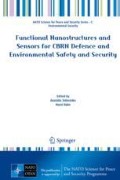Abstract
Nowadays it is highly important to have instruments for subatomic particles – neutrons monitoring with the high sensitivity that will prohibit widespread harsh environmental pollution, and with the capabilities to provide quantitative information as well as alarm functions. The development of new range of sensor materials has provided devices with enhanced selectivity and sensitivity.
Elaborated physical principles of work of 10B isotopes doped semiconductor nanosensitive elements and basis of their fabrication technology determine development of high-efficient nanosensors of the new construction.
It was found that Boron-containing materials mainly semiconductors are the best because of B10 isotope’s special neutron capture properties. Since neutrons are uncharged their detection depends on the secondary ionizing processes induced by the products of neutron capture reactions, most important of which is the capture by a 10B nucleus.
It was investigated: the peculiarities of the technology of laying the semiconductor Si thin films doped by 10B isotopes and studying the possibility of control of concentration and properties of Boron in Si nanostructures; parameters and main electro-physical characteristics of nanosensory elements; possibilities of their unification into sensory systems.
It was found that 7Li born as result that nuclear-chemical reaction is the shallow donor in Silicon nanostructures that positively influence on sensor element’s sensitivity.
Within the frame of the work it was done the comparative analysis of conditions of preparation 10B isotope contained neutron sensitive elements based on crystals of elementary Boron, Boron Carbide, Boron Nitride, and other different semiconductors included elementary ones and alloys.
Access this chapter
Tax calculation will be finalised at checkout
Purchases are for personal use only
References
Omoto A (2014) Japan’s nuclear R&D activities, The 15th FNCA ministerial level meeting, Sydney, Australia, November 19
Kervalishvili PJ (2012) Boron isotopes doped germanium and silicon based gamma and neutron radiation nanosensors. In: Book of 2nd international conference “nanotechnologies”, nano – 2012, September 19–21, Tbilisi, Georgia, p 120
Murty KL (2012) Chapter I: An introduction to nuclear materials: fundamentals and applications. Wiley/VCH, Berlin
Kervalishvili PJ (2012) Boron isotopes doped germanium and silicon based gamma and neutron radiation nanosensors. In: Book of 2nd interantional conference “nanotechnologies”, nano – 2012, September 19–21, 2012, Tbilisi, Georgia, p 120
Kervalishvili PJ, Yannakopoulos PH (2016) Nuclear radiation nanosensors and Nanosensory systems. In: NATO science for peace and security series B: physics, and biophysics. Springer, Dordrecht. 200p
Kervalishvili P (2009) Some neutron absorbing elements and devices for fast nuclear reactors regulation systems. NATO conference nuclear safety and security, Yerevan, Armenia, May 26–29
Kervalishvili P, Shavelashvili S (1987) The principle of recording neutrons with the AID of sensitive boron elements. Soviet At Energ 62(5):412–414
https://www.nuclear-power.net/wp-content/uploads/2015/08/Boron-neutron-reaction.png (2015)
Japanese Society of Neutron Capture Therapy.[c/o Laboratory for Chemistry and Life Science, Institute of Innovative Research, Tokyo Institute of Technology, R1–13, 4259 Nagatsuta-cho, Midori-ku, Yokohama, 226–8503, JAPAN]
National Nuclear Data Center. “NuDat 2.1 database”. Brookhaven National Laboratory. Retrieved 23 February (2017)
Kervalishvili PJ (2009) Boron based neutron absorbing elements and control systems. Abstracts – NATO Advanced Research Workshop, Boron Rich Solids, Orlando, Florida, USA
Rauschenbach HS (2012) Solar cell array design handbook: the principles and technology of photovoltaic energy conversion. Springer Science & Business Media, New York, p 157–. ISBN 978-94-011-7915-7
Weinberg I, Brandhorst Jr HW (1984) U.S. Patent 4,608,452, Lithium counter doped silicon solar cell
Bykovskii YA, Kervalishvili P, Nikolaev IN (1993) Neutron Fluence sensor based on boron carbide. Tech Phys Lett 19(7):457–458
Kervalishvili P, Shalamberidze S (1993) Semiconductor material film production by laser plasma deposition. Le Vide, le Couches Minces N267:189–197
Kervalishvili PJ, Berberashvili TM, Chakhvashvili LA, Goderdzishvili G, Yannakopoulos P, Davaris A (2011) Nuclear radiation nanosensors and nanosensory systems. eRA-6 – The Synergy Forum, International scientific conference, Piraeus, Greece 19–24 September
Kervalishvili P, Karumidze G, Kalandadze G (1993) Semiconductor sensor for neutrons. Sens Actuators, A 36(1):43–45
Kottou S, Nikolopoulos D, Petraki E, Bhattacharyya D, Kirby PB, Berberashvili TM, Chakhvashvili LA, Kervalishvili PJ, Yannakopoulos PH (2015) Monte-Carlo modelling and experimental study of radon and progeny radiation detectors for open environment. In: Progress in clean energy, volume 1, analysis and modeling. Springer International Publishing, Cham, pp 787–803
Kervalishvili PJ (2015) Novel approaches to nanosensory systems development. Am J Condens Matter Phys 5(1):1–9
Kervalishvili P, Berberashvili T, Chakhvashvili L (2011) About some novel nanosensors and nanosensory systems. Nano 4:155–164
Kervalishvili P (1990) About isotopic effect at interaction of substances with oxygen. J At Energ 68(N1):36–41
Kervalishvili PJ (2014) About isotope effects in condensed matter. Bull Russ Acad Nat Sci N1:3–10
Acknowledgments
I express my acknowledgment to all colleagues having collaborated with me in experimental, theoretical and technological activities and contributed to the development of work partly presented in this paper.
Author information
Authors and Affiliations
Editor information
Editors and Affiliations
Rights and permissions
Copyright information
© 2020 Springer Nature B.V.
About this paper
Cite this paper
Kervalishvili, P.J. (2020). BORON10 Isotope Based Neutron Radiation Semiconductor Sensors. In: Sidorenko, A., Hahn, H. (eds) Functional Nanostructures and Sensors for CBRN Defence and Environmental Safety and Security. NATO Science for Peace and Security Series C: Environmental Security. Springer, Dordrecht. https://doi.org/10.1007/978-94-024-1909-2_3
Download citation
DOI: https://doi.org/10.1007/978-94-024-1909-2_3
Published:
Publisher Name: Springer, Dordrecht
Print ISBN: 978-94-024-1908-5
Online ISBN: 978-94-024-1909-2
eBook Packages: Physics and AstronomyPhysics and Astronomy (R0)

